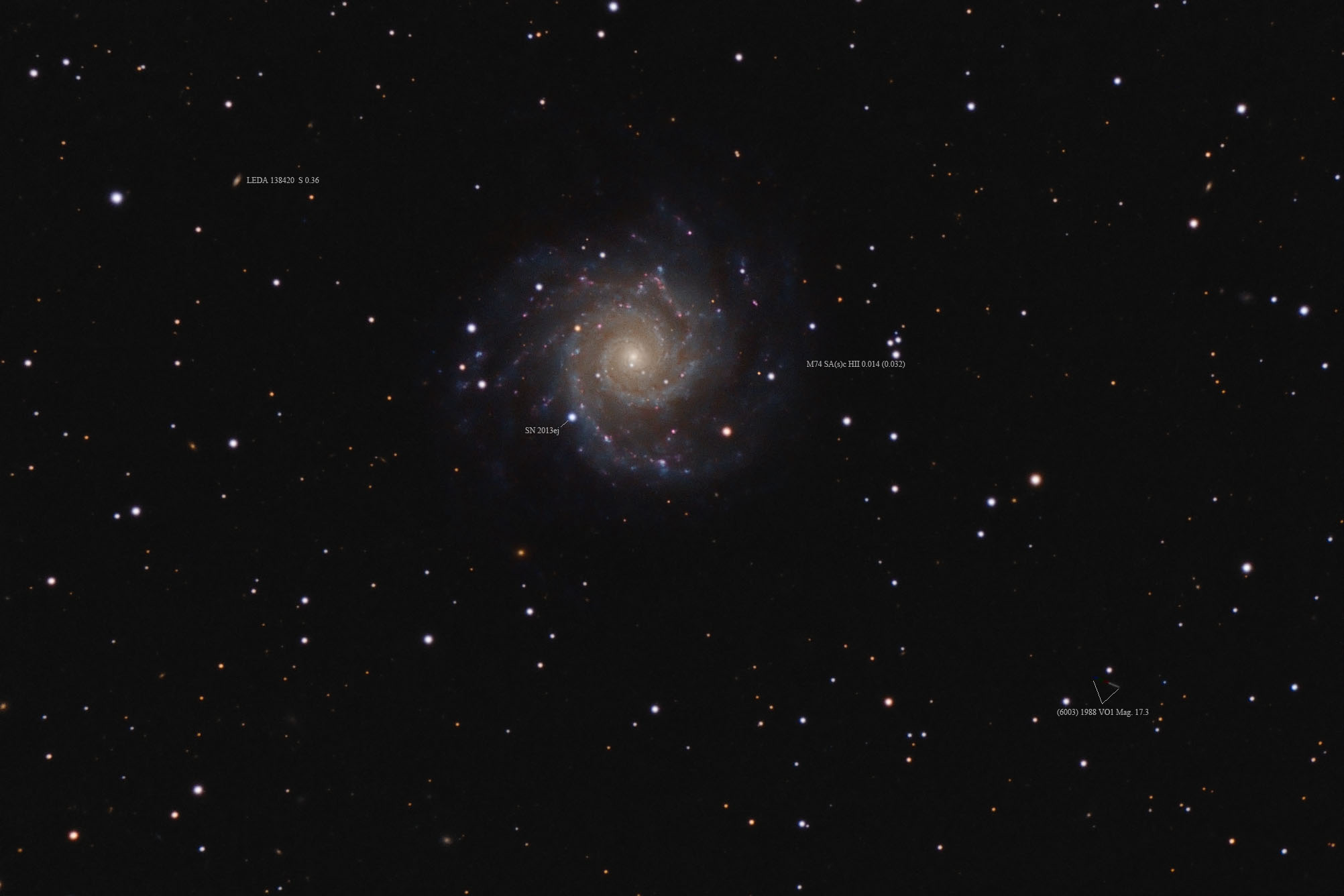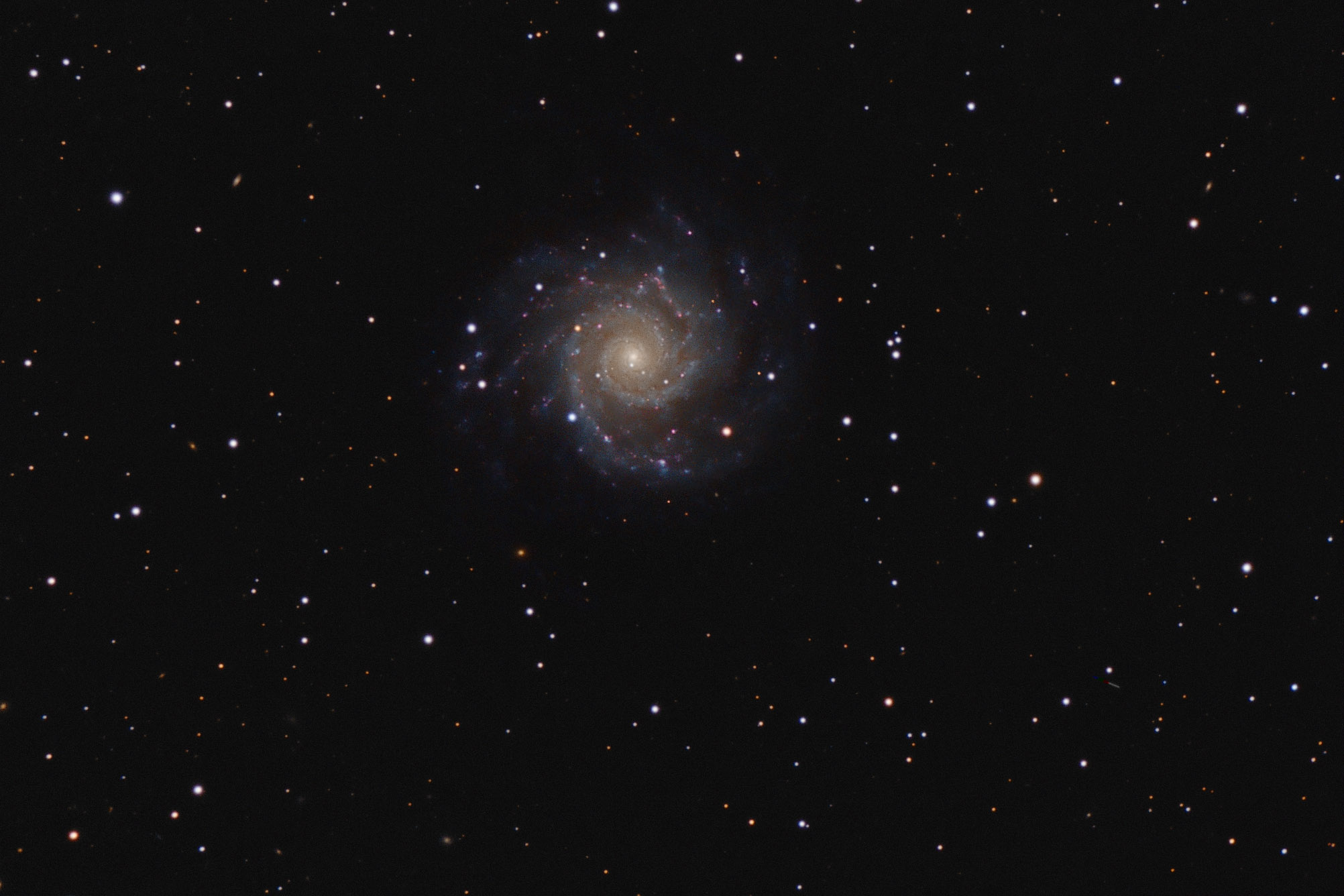Object name: M074Designation(s): M074, SN2013ej, M74 is a classic face on grand design spiral galaxy in Pisces about 32 million light-years away. Redshift puts it only 17 million light-years away but is highly unreliable when dealing with such short distances. Many other determinations all converge on the 32 million light-year distance. It is rather famous to those working on their Messier list with a small telescope as being possibly the most difficult of the Messier galaxies to see due to its very low surface brightness. Though I believe M101 has a fainter surface brightness, its larger angular size makes it easier to find. The galaxy is much studied by those working on the density wave theory of spiral structure as it is so close many of its brighter young stars can be seen in ground-based scopes while the HST can really dig into its guts. I'll save my fingers and let you read all about it at the HST site: http://hubblesite.org/gallery/album/pr2007041a/ . It appears to be about 94,000 light-years in diameter in my image.
While I imaged this one as about my first color image of a galaxy after moving to digital imaging the result was poor. Both due to my virtually nil processing skills and some mistakes in my imaging technique. It was always going to retake it but never seemed to get around to it. Instead, I reprocessed the old data but the results were less than satisfactory. That all changed a few days ago when Super Nova 2013ej was discovered in it on July 25th. Unfortunately, it is a very early morning object that never does rise to my normal imaging position of no more than 2 hours from the meridian before dawn. I make exceptions for events like this but the weather was the other issue. It just wouldn't cooperate. I made several abortive attempts that got so little of use I didn't use any of it but some color data from the previous night. By using both nights the color issues pretty much evened out. At least I hope they did. Reports have the supernova reddening the last few days. It is still very blue in my image. That just may mean it was even bluer earlier or maybe I have too little red. I hate trying to second guess clouds.
Fortunately, while clouds may reduce the photon count and thus signal to noise ratio, M74 is a bright galaxy and can suffer some loss and still look good. Thus the luminance data all taken August 7 due to its seeing being the best of the lot does work. The result is a much better version of M74 than I could eke out of the old data with many of its HII regions showing up and a 12.5 magnitude supernova to boot. If dawn would have held off another two hours it would have been better but we work with what the skies give us. For much of this year that's not much!
NED has little on the region but since I figured it best to point out which star was the supernova I went ahead and made an annotated image. There's even one asteroid at the bottom right. The color trail is from the second night.
14" LX200R @ f/10, L=4x10' RGB=4x10', STL-11000XM, Paramount MEM74 is a classic face on grand design spiral galaxy in Pisces about 32 million light-years away. Redshift puts it only 17 million light-years away but is highly unreliable when dealing with such short distances. Many other determinations all converge on the 32 million light-year distance. It is rather famous to those working on their Messier list with a small telescope as being possibly the most difficult of the Messier galaxies to see due to its very low surface brightness. Though I believe M101 has a fainter surface brightness, its larger angular size makes it easier to find. The galaxy is much studied by those working on the density wave theory of spiral structure as it is so close many of its brighter young stars can be seen in ground-based scopes while the HST can really dig into its guts. I'll save my fingers and let you read all about it at the HST site: http://hubblesite.org/gallery/album/pr2007041a/ . It appears to be about 94,000 light-years in diameter in my image.
While I imaged this one as about my first color image of a galaxy after moving to digital imaging the result was poor. Both due to my virtually nil processing skills and some mistakes in my imaging technique. It was always going to retake it but never seemed to get around to it. Instead, I reprocessed the old data but the results were less than satisfactory. That all changed a few days ago when Super Nova 2013ej was discovered in it on July 25th. Unfortunately, it is a very early morning object that never does rise to my normal imaging position of no more than 2 hours from the meridian before dawn. I make exceptions for events like this but the weather was the other issue. It just wouldn't cooperate. I made several abortive attempts that got so little of use I didn't use any of it but some color data from the previous night. By using both nights the color issues pretty much evened out. At least I hope they did. Reports have the supernova reddening the last few days. It is still very blue in my image. That just may mean it was even bluer earlier or maybe I have too little red. I hate trying to second guess clouds.
Fortunately, while clouds may reduce the photon count and thus signal to noise ratio, M74 is a bright galaxy and can suffer some loss and still look good. Thus the luminance data all taken August 7 due to its seeing being the best of the lot does work. The result is a much better version of M74 than I could eke out of the old data with many of its HII regions showing up and a 12.5 magnitude supernova to boot. If dawn would have held off another two hours it would have been better but we work with what the skies give us. For much of this year that's not much!
NED has little on the region but since I figured it best to point out which star was the supernova I went ahead and made an annotated image. There's even one asteroid at the bottom right. The color trail is from the second night.
14" LX200R @ f/10, L=4x10' RGB=4x10', STL-11000XM, Paramount ME Related Designation(s):11HUGS 029, 1AXG J013640+1548, 2MASS J01364173+1547008, 2MASX J01364177+1547004, 2XMM J013641.6+154701, 2XMMp J013641.6+154701, 87GB 013400.0+153119, 87GB[BWE91] 0134+1531, CGCG 0134.0+1532, CGCG 460-014, CXO J013641.7+154701, CXO J013641.74+154701.2, CXOU J013641.7+154701, HIPASS J0136+15, IRAS 01340+1532, IRAS F01339+1532, ISOSS J01366+1547, LGG 029:[G93] 005, M074, MCG +03-05-011, MESSIER 074, NGC 0628, NGC 0628:SN 2013ej, NGC 0628:[L2011a] X0014, NSA 130077, PGC 005974, PSN J01364816+1545310, SN 2013ej, SN2013ej, UGC 01149, UITBOC 0067, UZC J013641.7+154659, [CHP2004] J013641.7+154701, [DMA2007] J013641.73+154701.23, [HDM2013] 4q, [M98j] 022 NED01, [SLK2004] 0223, [WB92] 0134+1531, | | 
